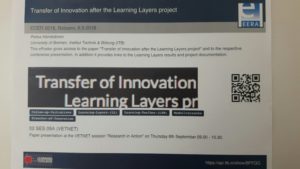Reflections on #ECER2018 – Part Two: Transfer of Innovation after the Learning Layers Project
In my previous post I started to report on our activities at the European Conference of Educational Research (ECER 2018) that took place last week in Bolzano/Bozen. In the first post I concentrated on the sessions that focused on the use of Learning Toolbox (LTB) as a digital toolset for preparing and presenting ePosters in conferences. In this second post I will concentrate on my own contributions that focus on the follow-up phase of our EU-funded Learning Layers (LL) project and on the issue ‘transfer of innovation’ after such a project. Firstly I will discuss my presentation on the research background of the LTB – prepared for the EERA session on using the LTB for ePosters. Secondly I will discuss my paper presentation on the theme “Transfer of Innovation after the Learning Layers project”.
However, this time I don’t want to provide simple summaries of two presentations. After all, we were at #ECER2018 with a pilot project in which the poster authors were trained to convert their traditional posters into ePosters with the help of LTB. So, I also took our own medicine and transformed my ‘ordinary’ PowerPoint presentations into hybrid presentations by using the LTB. Therefore, I want to give insights into the ePoster-versions of my presentations and what all has been packed into them alongside the initial PowerPoint presentations. Let me firstly give the link to the EERA showcase, where they can be found among others. Then we can have a look at each of the two presentations individually.
The research background and the research-related potential of the Learning Toolbox
The ‘ordinary’ ppt-presentation gives insights into the Learning Layers project, into the co-design activities in the Construction pilot, into the shaping and pilot testing of the Learning Toolbox (LTB) and into the reporting of the results. Then, the presentation gives an overview of research themes with which I have tried to put the innovation agenda into a wider context. And I have added a lot of references to relevant literature.
In my ‘ePoster-version‘ I have prepared an LTB-stack and told my story with few tiles that accommodate text documents. In addition I have used other tiles to link to web documents for presenting our project documentation and reporting. Then, on further screens I have given access to my research papers and to videos presenting our application partners’ views. In this way the ePoster-version provides a richer resource environment on the background of the LTB.
The ‘transfer of innovation’ issue before, during and after the Learning Layers project
Here, the ‘ordinary’ ppt-presentation gives some background information on the Learning Layers projects, on the co-design and pilot activities in the Construction pilot and describes the transition to the follow-up phase. Then, the second part discusses the ‘transfer issue’ as it was analysed in the light of earlier German Modellversuche, in more recent innovation programs and in specific pilots to promote transfer via ‘encounters’ and joint search processes. The presentation makes some comparisons between these earlier examples and our present situation. And here again, we have some literature.
In my ‘e-poster version‘ I have prepared a simple LTB-stack with two screens. The home screen gives access to the ppt-presentation and to the full paper and to my author information. The additional resource screen gives access to essential web links: the reports on Learning Layers results, the documentation of the Construction pilot as the “LTB-Chronicle”, the EERA-showcase with other ePosters. And concerning the literature, it provides two content tiles – literature on the transfer issue in Modellversuche (only paper-based) and my research papers uploaded on ResearchGate. In this way the ePoster-version has provided a somewhat richer resource environment.
—
I think this is enough of my contributions. I hope that this blog post helps to get access to the ePosters and to the resources they make available. If that is the case, it was worthwhile preparing them. But this is not all about the #ECER2018.
More blogs to come …


